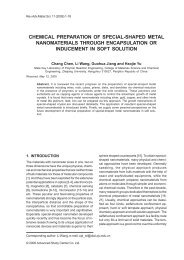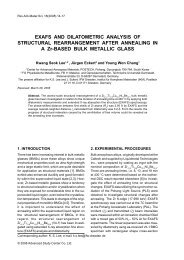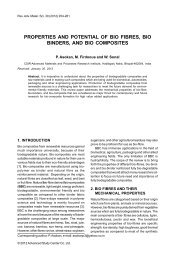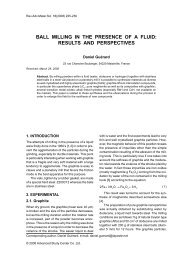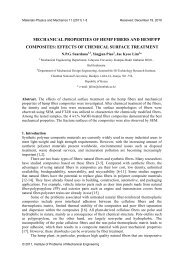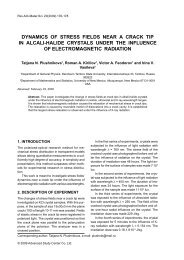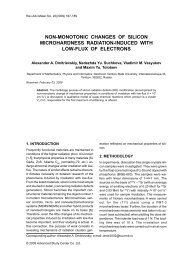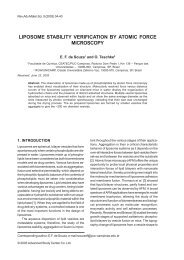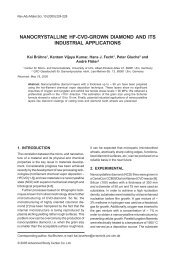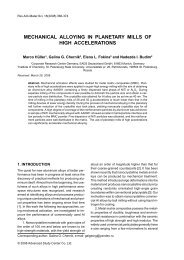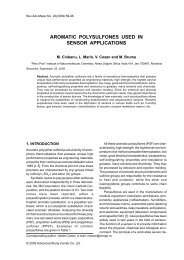surface pretreatment by phosphate conversion coatings – a review
surface pretreatment by phosphate conversion coatings – a review
surface pretreatment by phosphate conversion coatings – a review
Create successful ePaper yourself
Turn your PDF publications into a flip-book with our unique Google optimized e-Paper software.
162 T.S.N. Sankara Narayanan<br />
two minutes and allowed to drain the excess for<br />
three minutes [345]. The gain in weight of the<br />
<strong>phosphate</strong>d panels, when subjected to a humid<br />
atmosphere in a closed container at room temperature<br />
for six hours, gave the hygroscopicity<br />
of the coating [345].<br />
(e) Estimation of porosity. Estimation of the porosity<br />
of the <strong>phosphate</strong> coating involves both chemical<br />
and electrochemical methods. The chemical<br />
(Ferroxyl indicator) method was based on<br />
formation of blue spots (Prussian blue) on a filter<br />
paper dipped in potassium ferricyanide - sodium<br />
chloride - gelatin mixture when applied over<br />
the <strong>phosphate</strong>d <strong>surface</strong> for one minute. The number<br />
of blue spots per sq. cm gives a measure of<br />
the porosity of the coating. The electrochemical<br />
method of determination was based on the measurement<br />
of the oxygen reduction current density<br />
when immersed in air-saturated sodium hydroxide<br />
solution (pH 12). The current density<br />
values measured at -550 mV, where oxygen reduction<br />
is the dominant reaction at the uncoated<br />
areas reveals the porosity of the coating<br />
[209,210]. Although, both the Ferroxyl test and<br />
the electrochemical test are used in an industrial<br />
scale to assess the porosity of <strong>phosphate</strong>d<br />
steel, the former method is found to be qualitative<br />
and not very effective in distinguishing the<br />
porosities of panels <strong>phosphate</strong>d using different<br />
baths. In contrast, the electrochemical method<br />
is far reliable besides its simplicity in operation<br />
and quicker measurements of the porosity. The<br />
advantage of the electrochemical method has<br />
been discussed elsewhere [209, 346].<br />
(f) Determination of thermal and chemical stabilities.<br />
The thermal stability of the coating was usually<br />
determined <strong>by</strong> calculating the percentage<br />
loss in weight when the <strong>phosphate</strong>d panels were<br />
subjected to drying at 120 and 180 °C.<br />
The chemical stability of the coating, in particular,<br />
the alkaline stability is very important as it<br />
determines the effectiveness of the <strong>phosphate</strong><br />
coating as a base for cathodic electrophoretic<br />
finishes. This is determined <strong>by</strong> calculating the<br />
percentage residual coating when immersed in<br />
alkaline media. Immersion in sodium hydroxide<br />
solution is recommended to test the alkaline<br />
stability. Recently, Kwiatkowski et al. [347] have<br />
recommended a borate buffer solution containing<br />
0.01M EDTA as the medium to test the alkaline<br />
stability of the coating and proved its usefulness<br />
in predicting the same. A similar calculation<br />
of the percentage residual coating when<br />
subjected to immersion treatments in buffered<br />
solutions of varying pH from 2-14 can give an<br />
insight about ability of the <strong>phosphate</strong> <strong>coatings</strong><br />
to withstand different chemical aggressions and<br />
to prove their effectiveness in preventing the cosmetic<br />
corrosion [219].<br />
(g) Evaluation of <strong>surface</strong> morphology. The <strong>surface</strong><br />
morphology of the <strong>phosphate</strong> coating is usually<br />
assessed <strong>by</strong> scanning electron microscope<br />
(SEM). This technique reveals the distinct features<br />
of the crystal structure, grain size of the<br />
crystallites, the coating coverage and uniformity;<br />
the parameters that determine the performance<br />
of the coating.<br />
(h) Determination of ‘P ratio’. The ‘P ratio’ is usually<br />
determined <strong>by</strong> measuring the intensity of the<br />
characteristic planes of the constituent crystallites<br />
of the <strong>phosphate</strong> coating. In a zinc <strong>phosphate</strong><br />
coating, which consists essentially of<br />
hopeite (Zn (PO ) . 4H2O) and phosphophyllite<br />
3 4 2<br />
(Zn Fe(PO ) . 4H2O), the ‘P ratio’ is defined as<br />
2 4 2<br />
[199]:<br />
‘P ratio’ = P<br />
P + H<br />
Where P <strong>–</strong> Intensity of the characteristic planes<br />
of phosphophyllite and H <strong>–</strong> Intensity of the<br />
characteristic planes of hopeite.<br />
(i) Adhesion measurements. The standard laboratory<br />
method of estimation of adhesion is the peel<br />
off test, which involves the determination of the<br />
extent of adhesion at scribed areas using a pressure<br />
sensitive adhesive tape. Usually adhesion<br />
in the dry state will be good since it mainly depends<br />
on the cohesive failure of the paint film.<br />
Wet adhesion is of prime importance and is usually<br />
determined after subjecting the painted panels<br />
to immersion treatment in de-ionized water<br />
at 45 °C for 240 hours. Depending upon the extent<br />
of peeling, rating will be made between 0<br />
and 5B as per ASTM D 3359-87 [348].<br />
3.11.2. Evaluation of corrosion performance<br />
(a) Rapid preliminary quality control tests. Preliminary<br />
investigation of coating quality for on-line<br />
monitoring mainly involves two empirical tests<br />
of which one involves inspection for rust spots<br />
after immersion in 3% sodium chloride solution<br />
for 5-30 minutes and the other is concerned with<br />
the time taken for metallic copper deposition from<br />
a copper sulphate-sodium chloride-hydrochloric<br />
acid mixture.<br />
(b) Laboratory corrosion resistance tests. The most<br />
frequently used laboratory tests for evaluating



